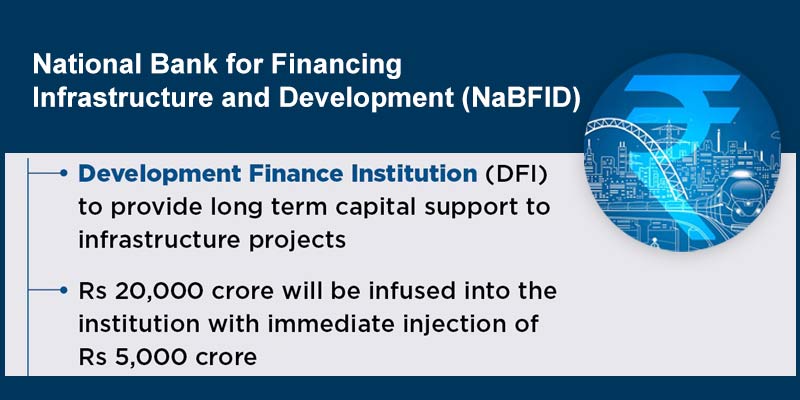- India
- Nov 08
What is the purpose of NaBFID?
The finance ministry will soon start the process for the appointment of managing director (MD) and deputy managing directors (DMDs) of the newly set up Rs 20,000 crore development finance institution NaBFID.
Last month, the government appointed veteran banker K.V. Kamath as the chairperson of the National Bank for Financing Infrastructure and Development (NaBFID) for three years.
As per the National Bank for Financing Infrastructure and Development (NaBFID) Act 2021, the institution would have one MD and not more than three DMDs.
Setting up of DFI
• The National Bank for Financing Infrastructure and Development Bill, 2021 was passed in the Parliament in March this year.
• Earlier, the Union Cabinet had approved to set up a Development Finance Institution (DFI) to raise long-term capital to fund infrastructure development.
• Its prime objective was to establish the National Bank for Financing Infrastructure and Development (NaBFID) to support the development of long term non-recourse infrastructure financing in India, including development of the bonds and derivatives markets necessary for infrastructure financing and to carry on the business of financing infrastructure.
Are DFIs a new concept?
• During the pre-liberalised era, India had DFIs which were primarily engaged in the development of industry.
• ICICI and IDBI, in their previous avatars, were DFIs. Even the country’s oldest financial institution IFCI Ltd functioned as a DFI.
• In India, the first DFI was operationalised in 1948, with the setting up of the Industrial Finance Corporation of India (IFCI).
• Subsequently, the Industrial Credit and Investment Corporation of India (ICICI) was set up with the backing of the World Bank in 1955.
• The Industrial Development Bank of India (IDBI) came into existence in 1964, to promote long-term financing for infrastructure projects and industry.
What is the need for such an institution?
• Infrastructure financing requires long-term and non-recourse financing, which is inherently risky in nature due to higher credit costs, high risk of delay and failure of projects.
• Traditionally, banks and financial institutions in India have been an important source of financing for infrastructure sector. While banks rely heavily on short-term liabilities, infrastructure financing essentially involves long-term finance.
• Consequently, exposure to long-term infrastructure financing has been a fundamental source of asset-liability mismatch on the balance-sheets of the banks which raises systemic concerns.
• On the other hand, the Indian corporate bond market is not sufficiently deep and is inadequate to meet India’s infrastructure financing requirements.
• The government decided to intervene to facilitate and to enable flow of low cost, long-term, patient capital (primarily debt) from India or abroad into greenfield infrastructure projects to foster sustainable economic development.
• It decided to set up a statutory institution — National Bank for Financing Infrastructure and Development (NaBFID) — as the principal development financial institution and development bank for infrastructure financing.
• The institution will be 100 per cent government owned.
What is the purpose of NaBFID?
• It aims to address market failures that stem from the long-term, low margin and risky nature of infrastructure financing.
• The government will provide the institution with grants and contributions, guarantees at concessional rates for foreign borrowings and any other concessions.
• The government has committed Rs 5,000 crore grant over and above Rs 20,000 crore equity capital.
• The government will also provide guarantee at a concessional rate of up to 0.1 per cent for borrowing from multilateral institutions, sovereign wealth funds, and other foreign funds.
• It will help fund infra projects under the National Infrastructure Pipeline (NIP) which envisages an investment of Rs 111 lakh crore by 2024-25.
• The DFI will remain outside the purview of CAG, CVC and CBI, a move aimed at enabling faster decision-making.
• The government expects the DFI to leverage this fund to raise up to Rs 3 lakh crore in the next few years.
Key functions of NaBFID:
• The institution shall have both developmental and financial objectives.
• Among other things, this would include developing a deep and liquid bond market of international standards for long-term infrastructure financing in India including through widening of the issuer and investor base.
• It would also facilitate the development of markets for interest rate derivatives, credit derivatives, currency derivatives and such other innovative financial instruments as may be necessary for infrastructure financing.
• The financing objectives would involve establishing a credible framework that attracts equity investments from domestic and global institutional investors as well as debt investments, including green finance, from investors, aligned to their risk appetite and asset-liability profile, in order to cater the financing needs of the infrastructure sector.
• Overall, the institution shall provide a supporting, technology-enabled ecosystem across the life-cycle of infrastructure projects as a provider, enabler and catalyst for sustainable infrastructure financing in India with the backing of the government.
Manorama Yearbook app is now available on Google Play Store and iOS App Store

